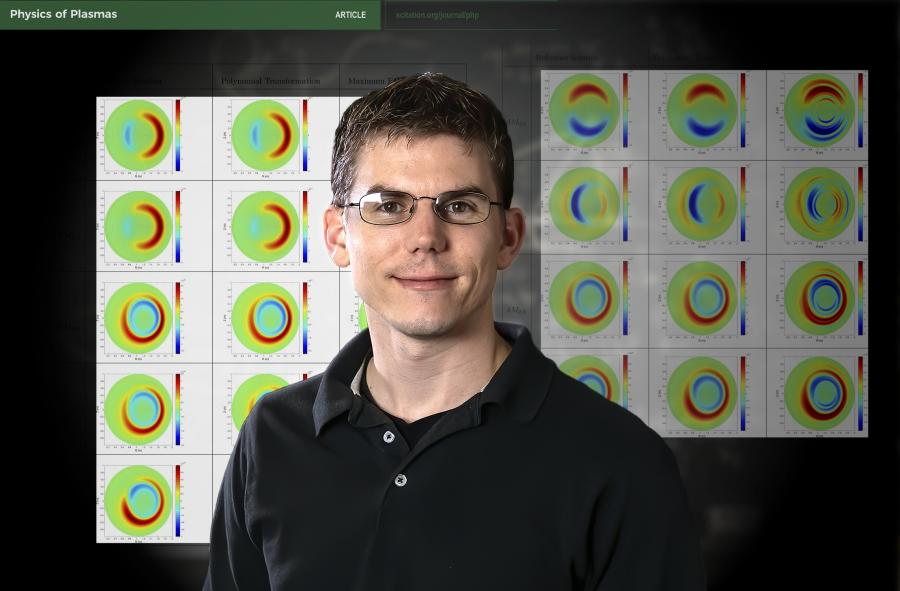Apr 16 2020
Predicting the performance of volatile plasma that powers fusion reactions is a major problem for researchers, who are looking for ways to achieve the fusion energy that fuels the stars and the Sun to Earth.
 Physicist Ben Sturdevant with figures from paper. Image Credit: Photo and composite by Elle Starkman/PPPL Office of Communications.
Physicist Ben Sturdevant with figures from paper. Image Credit: Photo and composite by Elle Starkman/PPPL Office of Communications.
To make such forecasts, a significant amount of time had to be spent on the world’s fastest supercomputers. Now, scientists at the Princeton Plasma Physics Laboratory (PPPL) at the U.S. Department of Energy (DOE) have employed a method from applied mathematics to speed up this prediction process.
In this method, the millisecond behavior of fusion plasmas is combined into longer-term forecasts.
By applying this method, “we were able to demonstrate that accurate predictions of quantities such as plasma temperature profiles and heat fluxes could be achieved at a much reduced computational cost,” stated Ben Sturdevant, an applied mathematician at PPPL and also the lead author of the Physics of Plasmas study that announced the results.
During fusion, light elements are combined in the form of plasma that produces large amounts of energy. Plasma is a hot, charged state of matter made up of atomic nuclei and free electrons. Globally, researchers are working to produce and regulate fusion energy on Earth for limitless supply of clean and safe energy to produce electricity.
Speeding Simulations
A research team, headed by physicist C.S. Chang at PPPL, had successfully developed a high-performance XGCa plasma code. Sturdevant eventually applied the mathematical method to this XGCa plasma code.
This application considerably accelerated the simulations of the emerging temperature profile of ions that orbit around the magnetic field lines modeled using gyrokinetics. Gyrokinetics is an extensively used model that offers an in-depth microscopic explanation of plasma’s behavior in powerful magnetic fields.
The application also helped to quickly model the collisions that occur between orbiting particles that are responsible for causing heat to escape from the plasma and minimize its performance.
This was the first application to successfully use the method, known as “equation-free projective integration,” to model the evolving temperature profile of ions as colliding particles exit from magnetic confinement.
The aim of equation-free modeling is to obtain long-term macroscopic data from short-term microscopic simulations. Here, the key was to enhance a vital aspect of the technique known as a “lifting operator” to plot the macroscopic, or large-scale, states of the behavior of plasma onto microscopic, or small-scale, ones. Such an alteration brought the in-depth temperature profile of the ions into sharp relief.
Rather than directly simulating the evolution over a long time-scale, this method uses a number of millisecond simulations to make predictions over a longer time-scale. The improved process reduced the computing time by a factor of four.
Ben Sturdevant, Study Lead Author and Applied Mathematician, Princeton Plasma Physics Laboratory
The outcomes, which are built on tokamak simulations, are broad and can possibly be modified for other kinds of magnetic fusion devices, such as stellarators, and also for other types of scientific applications.
This is an important step in being able to confidently predict performance in fusion energy devices from first-principles-based physics.
Ben Sturdevant, Study Lead Author and Applied Mathematician, Princeton Plasma Physics Laboratory
Expanding the Technique
Next, Sturdevant intends to factor in the impact of expanding the method to include the evolution of turbulence on the process speed.
Some of these initial results are promising and exciting. We’re very interested to see how it will work with the inclusion of turbulence.
Ben Sturdevant, Study Lead Author and Applied Mathematician, Princeton Plasma Physics Laboratory
The study’s coauthors include Chang, PPPL physicist Robert Hager, and physicist Scott Parker from the University of Colorado. Both Chang and Parker were advisors, informed Sturdevanti, while Hager extended help with the computational analysis and the XGCa code.
The study was financially supported by the Exascale Computing Project, a joint effort of the National Nuclear Security Administration and the DOE Office of Science, and Scientific Discovery via Advanced Computing (SciDAC).
Computer simulations were carried out at the National Energy Research Scientific Computing Center (NERSC)—a DOE Office of Science User Facility.